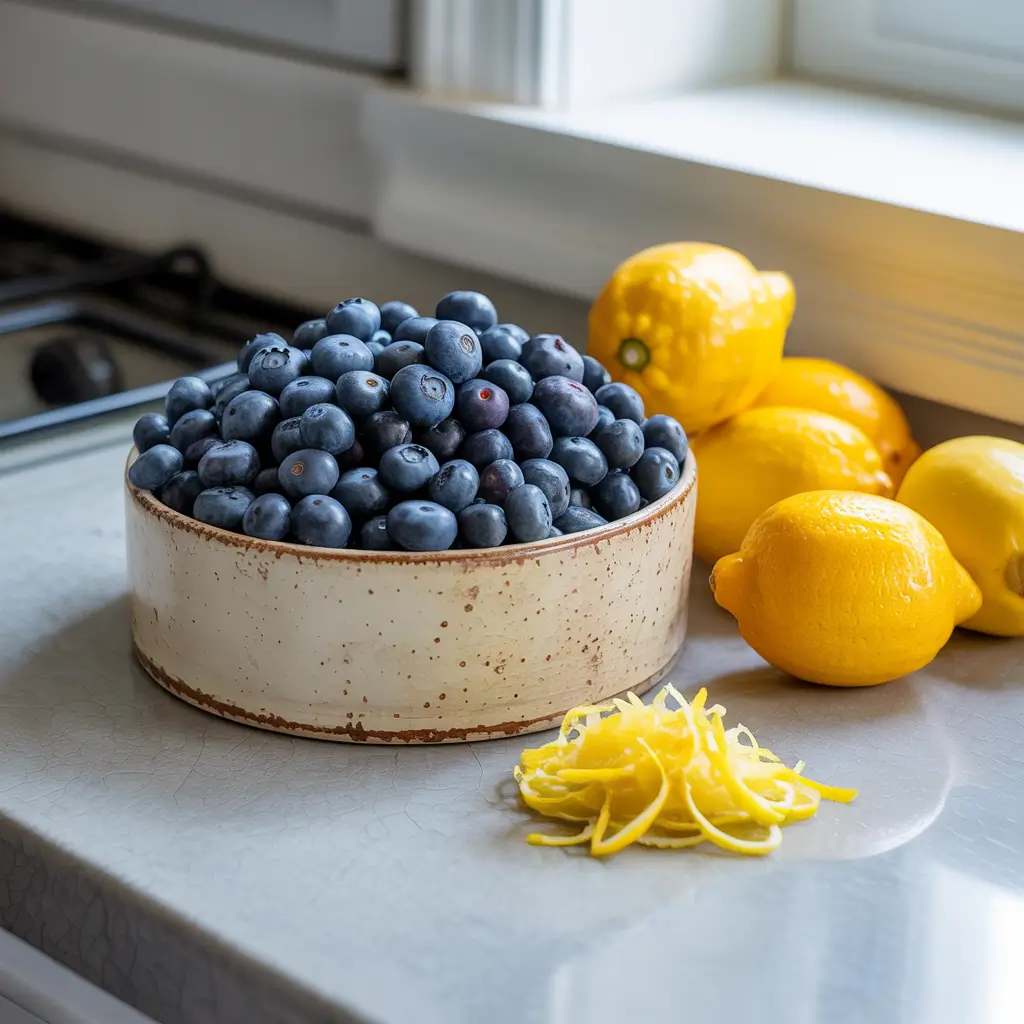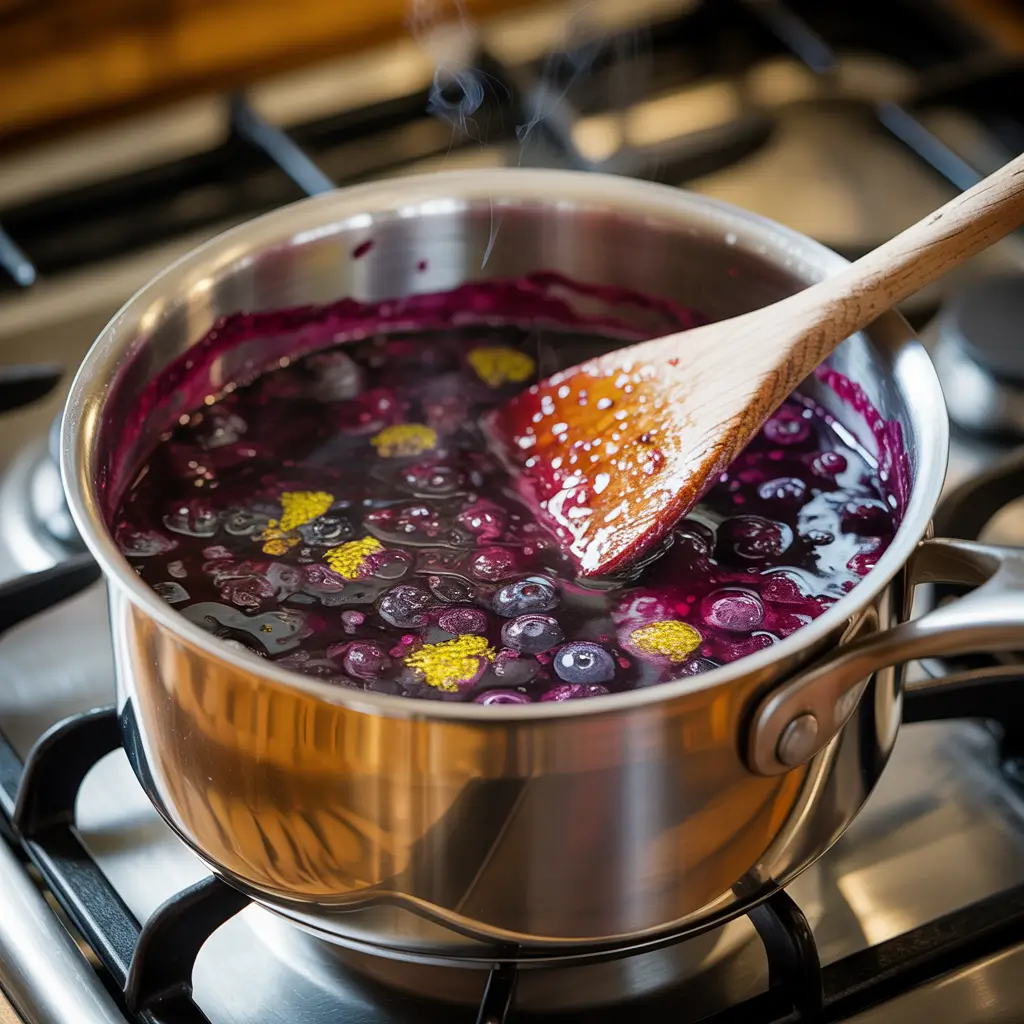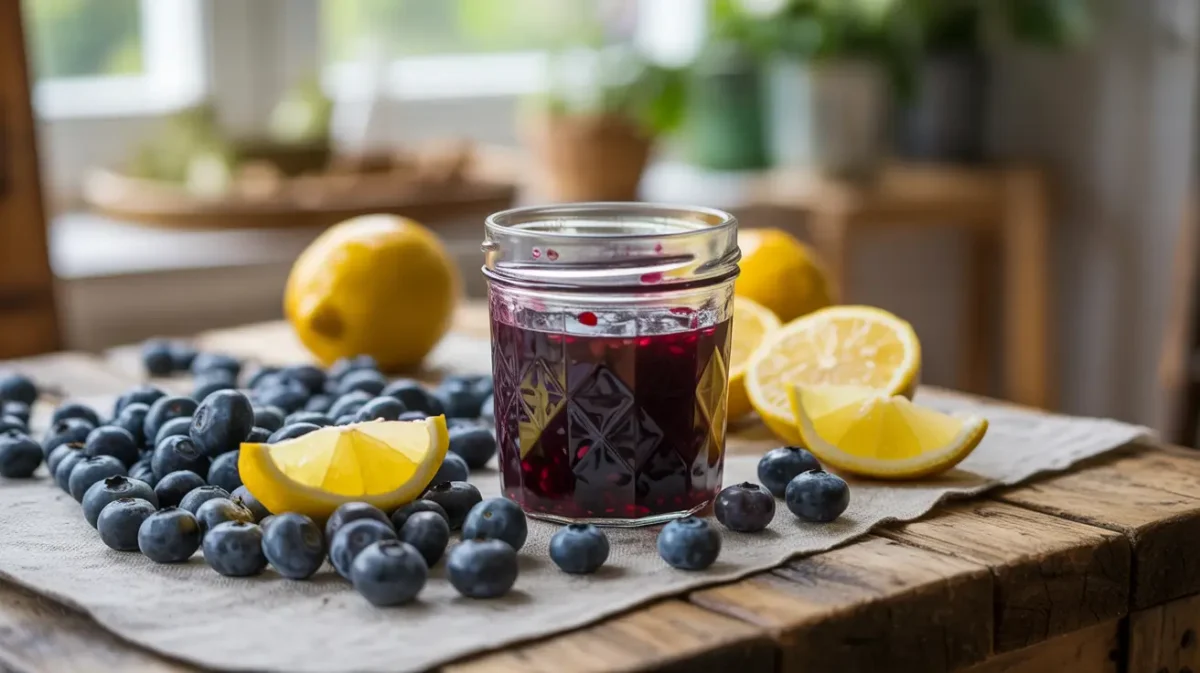Blueberry and lemon jam blends the sweet juiciness of blueberries with the bright, zesty kick of lemon for a perfectly balanced flavor. This vibrant spread is delicious on warm toast, swirled into yogurt, or spooned over cheesecake for a fruity twist. Whether made with fresh seasonal berries or frozen fruit, it always delivers a burst of freshness. Pair it with blueberry lemon muffins for an irresistible flavor duo. In this guide, you’ll discover its benefits, key recipe tips, storage methods, and creative serving ideas to make the most of this versatile jam.
table of contets
Table of Contents
Blueberry and Lemon Jam – A Zesty Homemade Delight
Blueberry and lemon jam blends sweet, juicy blueberries with the bright, zesty kick of lemon for a perfectly balanced spread that’s delicious on toast, swirled into yogurt, or spooned over cheesecake.
- Prep Time: 10 minutes
- Cook Time: 30 minutes
- Total Time: 40 minutes
- Yield: 4 cups
- Category: Condiment
- Method: Stovetop
- Cuisine: American
Ingredients
- 2 lbs fresh or frozen blueberries (thawed and drained if frozen)
- 2 cups granulated sugar
- 1 medium lemon (zested and juiced)
- Optional: 1/4 tsp cinnamon or fresh thyme for variation
Instructions
- Wash blueberries, removing stems and damaged berries. If using frozen, thaw and drain slightly.
- Zest and juice the lemon, setting both aside.
- In a heavy-bottomed saucepan, combine blueberries, lemon zest, lemon juice, and sugar.
- Cook over medium heat, stirring until sugar dissolves and berries begin to release juice.
- Lightly mash berries for a smoother texture, or leave some whole for chunkiness.
- Bring to a gentle boil, then reduce heat and simmer for 20–30 minutes, stirring occasionally, until thickened.
- Test for set by placing a small amount on a chilled plate; if it wrinkles when pushed, it’s ready.
- Ladle hot jam into sterilized jars, leaving 1/4-inch headspace.
- Seal jars and refrigerate for short-term storage, or process in a boiling water bath for long-term storage.
Notes
For a sugar-free version, use low-sugar pectin and a natural sweetener like honey or stevia. Jam can also be frozen for up to 6 months.
Introduction to Blueberry and Lemon Jam
The Irresistible Combo of Blueberries and Lemon
When it comes to flavor pairings, few are as naturally perfect as blueberries and lemon. Plump, ripe blueberries bring rich, fruity sweetness, while bright lemon adds a crisp citrus tang, coming together in a jam that’s equal parts refreshing and comforting. In blueberry and lemon jam, the lemon’s acidity not only brightens the flavor but also helps the jam set, thanks to its pectin content. Blueberries bring a rich purple hue and subtle floral undertones, while lemon keeps the taste light and zesty. It’s the reason you’ll often see this combination in baked goods like lemon and blueberry bread or muffins.
When spread over warm toast or flaky scones, this jam feels indulgent yet balanced. The sweet-tart blend works equally well in sweet treats or savory pairings like soft cheeses, roasted meats, or a dollop on pancakes.
Why This Flavor Pairing Works So Well
The success of blueberry and lemon jam isn’t random — it’s culinary chemistry. Blueberries are naturally sweet with mild acidity, while lemons deliver a high dose of citric acid. This acidity enhances aroma, sharpens sweetness, and keeps the flavor from feeling heavy. Both fruits are summer stars, meaning they can be harvested fresh at the same time for optimal flavor. Even when using frozen fruit, the vibrant taste remains.
For another creative twist, the duo shines in desserts like air fryer lemon blueberry bread — proof that this combination works beautifully in almost any recipe.
Benefits of Blueberry and Lemon Jam

Nutritional Perks of Blueberries
Blueberries aren’t just delicious — they’re a nutritional powerhouse. Packed with antioxidants like anthocyanins, these little berries help combat free radicals and support overall health. They’re also a good source of vitamin C, vitamin K, and dietary fiber, making blueberry and lemon jam a more wholesome treat compared to highly processed spreads. Even in jam form, many of these nutrients remain, especially when cooked gently to preserve flavor and color. Regular consumption of blueberries has been linked to improved heart health, better brain function, and reduced inflammation.
Health Benefits of Lemon Zest and Juice
Lemon juice and zest do more than boost flavor — they offer their own health perks. Lemons are a powerhouse of vitamin C, which helps strengthen the immune system and supports radiant, healthy skin.
Lemon zest is packed with essential oils and flavonoids, offering antioxidant and anti-inflammatory properties that boost overall wellness.
In jam-making, lemon is more than just flavor — its acidity activates the natural pectin in blueberries, helping the mixture set without added thickeners.
And beyond the health perks, there’s the simple joy it brings — few pleasures compare to spreading a spoonful of homemade jam over a slice of freshly baked bread. In jam-making, lemon plays a key role in helping the mixture set naturally by activating the pectin found in blueberries.
Beyond nutrition, there’s the emotional comfort factor — few things are as satisfying as spreading homemade jam on fresh bread. For an extra indulgence, enjoy your jar alongside creamy toppings like those at Top It Yogurt Shoppe for a dessert-like treat that still offers a dose of fruit-based goodness.
Together, blueberries and lemon deliver a burst of flavor that’s as beneficial for your body as it is pleasing to your taste buds. This makes blueberry and lemon jam a smart choice for anyone looking to enjoy a sweet spread without too much guilt.
Ingredients for the Perfect Blueberry and lemon jam
Choosing the Best Fresh or Frozen Blueberries
The foundation of great blueberry and lemon jam starts with high-quality blueberries. Fresh berries in peak season, usually mid-summer, offer the sweetest and most intense flavor. Look for plump, firm berries with a deep blue color and a light, silvery bloom on the skin — a sign of freshness. If fresh blueberries aren’t available, frozen ones are an excellent alternative. They’re typically picked and frozen at peak ripeness, locking in nutrients and flavor. Just remember to thaw and drain them slightly before cooking to avoid excess water in your jam.
How to Pick the Juiciest Lemons for Jam
The lemon in your jam plays more than one role — Blueberry and lemon jam enhances flavor, helps balance sweetness, and aids in the setting process. Choose lemons that feel heavy for their size, which indicates high juice content. Their skin should be bright yellow and slightly glossy, without green patches that signal under-ripeness. For the best aroma, opt for unwaxed lemons so you can safely use the zest, which adds vibrant flavor and natural oils.
When it comes to proportions, most recipes use about one medium lemon for every pound of blueberries. This ratio ensures the perfect sweet-tart balance without overpowering the berries. If you prefer a more pronounced citrus kick, you can add a bit more zest without affecting the jam’s consistency.
By starting with the best ingredients, you set yourself up for a jar of blueberry and lemon jam that’s bursting with fresh, natural flavor.
Step-by-Step Blueberry and Lemon Jam Recipe

Preparing the Fruit for Maximum Flavor
To create the best blueberry and lemon jam, start by washing your blueberries under cool running water, removing any stems or damaged berries. If you’re using frozen blueberries, thaw them in a colander to drain excess liquid, which can make the jam too runny. Next, zest your lemon before juicing it — zesting first ensures you capture all those fragrant oils without struggling with a slippery fruit. The zest will add aromatic depth, while the juice provides acidity to balance the sweetness and help the jam set.
Cooking Techniques for Perfect Consistency
Place the blueberries, lemon zest, lemon juice, and sugar into a heavy-bottomed saucepan. Warm over medium heat, stirring gently until the sugar completely dissolves. As the mixture cooks, the berries will release their juices and soften. If you prefer a smooth consistency, lightly mash the fruit with a potato masher; for a chunkier texture, leave some berries whole.
Bring the mixture to a gentle boil, then reduce the heat to maintain a slow simmer. Cook for 20–30 minutes, stirring occasionally, until the jam thickens. To test for readiness, drop a small spoonful onto a chilled plate — if it wrinkles when pushed with your finger, it’s set. Skim off any foam that rises to the surface for a clear, glossy result.
Carefully ladle the hot jam into sterilized jars and allow it to cool slightly before sealing. Keep refrigerated for short-term enjoyment, or preserve it for longer storage by processing the jars in a water bath. With these steps, you’ll have homemade blueberry and lemon jam that’s rich, flavorful, and perfectly set.
Understanding the Role of Lemon in Jam Making
How Lemon Juice Affects Pectin and Setting
One of the main reasons lemon is a must in blueberry and lemon jam is its role in activating pectin. Pectin is a natural carbohydrate found in many fruits that helps jams gel. While blueberries contain some pectin, they don’t have enough to achieve a firm set on their own. Lemon juice adds the acidity needed to trigger the gelling process, giving your jam the perfect texture — spreadable but not runny. Without enough acid, the jam may remain loose, even after prolonged cooking.
The amount of lemon juice matters. Too little, and your jam won’t set properly; too much, and the flavor may become overly tart. Most recipes balance about two tablespoons of lemon juice per pound of fruit to achieve the ideal consistency and flavor.
The Flavor-Balancing Magic of Lemon Zest
Beyond its functional role, lemon adds a bright, fresh taste that enhances the blueberries’ natural sweetness. Lemon zest, in particular, infuses the jam with aromatic oils that give a more rounded citrus flavor without increasing acidity. This prevents the jam from tasting overly sweet or heavy, making each bite more vibrant.
In essence, lemon works double duty — it’s the key to both structure and flavor. Without it, blueberry jam risks being flat in taste and inconsistent in texture. With it, you get a lively, well-balanced preserve that’s as beautiful to spread as it is to taste.
Variations and Creative Twists
Adding Spices or Herbs to Enhance Flavor
While the classic blueberry and lemon jam combination is irresistible on its own, adding spices or herbs can take it to a whole new level. A pinch of cinnamon or nutmeg adds warmth, making the jam perfect for cozy winter mornings. For a more exotic twist, try cardamom — its floral notes pair beautifully with blueberries and lemon. Herbs like fresh thyme or basil can lend a refreshing, savory edge that’s ideal for pairing with cheeses or roasted meats.
To infuse these flavors, simply add your chosen spice or herb during the cooking process and remove any whole stems or leaves before jarring. The result is a more complex jam that still highlights the star ingredients.
Sugar-Free and Low-Sugar Blueberry-Lemon Jam Options
For those looking to reduce sugar, you can make a delicious low-sugar or sugar-free version without sacrificing flavor. Use a low-sugar pectin, which is formulated to gel with less sweetener, and replace sugar with honey, maple syrup, or a sugar substitute like stevia. Keep in mind that alternative sweeteners can slightly alter the texture and shelf life, so refrigerate or freeze these versions for best results.
Another option is to let the natural sweetness of the blueberries shine by using very ripe fruit. Paired with the tang of lemon, the jam still tastes vibrant and fresh — just a bit less indulgent.
Experimenting with variations not only keeps things exciting but also allows you to tailor your blueberry and lemon jam to your taste preferences and dietary needs.
Serving and Pairing Ideas

What Pairs Well with Blueberry Jam
Here’s a unique rewrite of your sentence:
« What makes blueberry and lemon jam truly special is its incredible versatility. ». For breakfast, it’s a natural match for warm toast, buttery croissants, or fluffy pancakes. Swirl it into oatmeal or yogurt for a quick, fruity upgrade — the creamy base contrasts beautifully with the jam’s tangy sweetness. It also works well as a topping for waffles or French toast, giving a burst of berry flavor in every bite.
For something more indulgent, spoon it over ice cream or use it as a filling in cakes and pastries. Soft cheeses like brie, cream cheese, or mascarpone pair especially well, creating an elegant appetizer for gatherings. Even savory dishes, such as roasted chicken or pork, benefit from a glossy spoonful of blueberry and lemon jam as a glaze.
Breakfast, Dessert, and Snack Inspirations
If you’re looking to get creative, consider using the jam in baked goods like muffins, scones, or coffee cakes. It’s also a fantastic filling for sandwich cookies or a fruity swirl in cheesecakes. For an extra treat, layer it between cake sponges for a citrusy berry surprise.
And if you want a grab-and-go snack idea, spread it on a rice cake or whole-grain cracker with a touch of almond butter — quick, tasty, and satisfying.
Whether you stick to the classics or explore unique pairings, blueberry and lemon jam is a flavor companion that adapts beautifully to any occasion. For more presentation and pairing inspiration, check out our Pinterest collection of blueberry and lemon ideas.
Storage and Shelf Life Tips
Best Methods for Canning Blueberry and Lemon Jam
To enjoy blueberry and lemon jam for months, proper canning is essential. Begin by sterilizing the jars and lids in boiling water for a minimum of 10 minutes. While still hot, fill the jars with the freshly made jam, leaving roughly ¼ inch of space at the top. Wipe the rims to remove any residue, secure the lids, and process the filled jars in a boiling water bath for 10–15 minutes to ensure a proper seal. This heat-sealing method prevents bacteria growth and allows you to store your jam at room temperature for up to a year. Always label jars with the date so you know when they’re at their best.
Refrigeration and Freezing Guidelines
If you’re making a small batch for quick use, simply pour the cooled jam into clean jars and store it in the refrigerator. It will stay fresh for 2–4 weeks. For longer storage without canning, freezing is an excellent option. Use freezer-safe containers, leaving space at the top for expansion, and the jam will keep its flavor for up to 6 months.
Once opened, always store the jar in the fridge and use a clean spoon each time to avoid contamination. If you notice any off smells, mold, or unusual color changes, discard it immediately.
By following these storage methods, you can enjoy the vibrant taste of blueberry and lemon jam long after blueberry season has passed.
Frequently Asked Questions
Do blueberries and lemon go together?
Yes. The sweetness of blueberries and the tang of lemon create a balanced, refreshing flavor perfect for jams, bakes, and drinks.
What pairs well with blueberry jam?
It’s great with toast, scones, pancakes, creamy cheeses, or as a glaze for meats.
What does lemon juice do to jam?
It adds brightness and helps the jam set by activating natural pectin.
Is blueberry and lemon juice good for you?
Yes. Both are rich in vitamins and antioxidants, offering immune and digestive benefits.
Conclusion
From its vibrant color to its sweet-tart flavor, blueberry and lemon jam is a simple yet impressive way to capture the best of summer fruit. With just a few quality ingredients and the right cooking method, you can create a homemade spread that works for breakfast, desserts, or even savory dishes. Whether you enjoy it fresh from the fridge or preserve it for later, the combination of blueberries and lemon never disappoints. Don’t miss our easy blueberry and lemon muffins for another delicious way to enjoy this timeless pairing. And if you make your own jam, share your creations with us on Facebook — we love seeing your kitchen successes.


